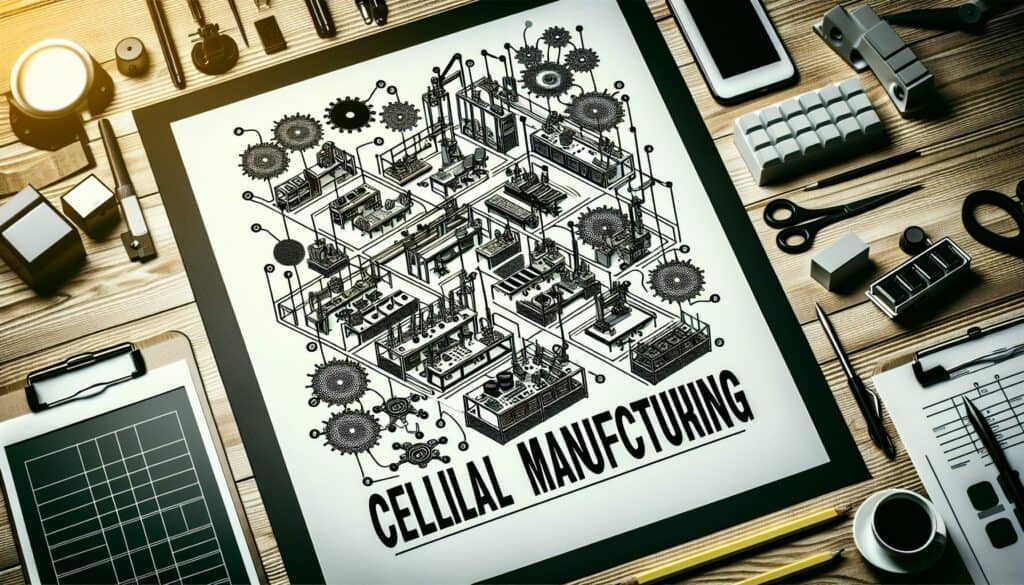Migliorare l'efficienza produttiva raggruppando macchine diverse in celle che lavorano su prodotti con requisiti di lavorazione simili (famiglie di pezzi).
- Metodologie: Ingegneria, Qualità
Produzione cellulare

Produzione cellulare
- Miglioramento continuo, Just-in-Time (JIT), Produzione snella, Miglioramento dei processi, Efficienza della produzione, Gestione della qualità, Mappatura del flusso di valore
Obiettivo:
Come si usa:
- Le postazioni di lavoro e le attrezzature sono disposte in sequenza per consentire un flusso regolare di materiali e componenti attraverso il processo produttivo, con trasporti e ritardi minimi. Una cella è responsabile della produzione di una famiglia di pezzi simili.
Professionisti
- Riduce le scorte di prodotti in lavorazione, i tempi di consegna e la movimentazione dei materiali; migliora la flessibilità, il morale dei lavoratori e la qualità; risparmia spazio in fabbrica.
Contro
- Può essere costoso da implementare (riorganizzazione delle attrezzature, formazione); richiede un'attenta pianificazione e l'identificazione della famiglia di pezzi; l'utilizzo delle macchine all'interno di una cella può essere inferiore se non è bilanciato correttamente; è vulnerabile ai guasti se una macchina in una cella si guasta.
Categorie:
- Lean Sigma, Produzione, Progettazione del prodotto
Ideale per:
- Migliorare il flusso e l'efficienza della produzione di alta qualità e di volumi medio-bassi creando unità di produzione dedicate e mirate.
Cellular manufacturing is particularly effective in industries such as automotive, electronics, and appliance manufacturing, where product lines often consist of a variety of components requiring customized assembly processes. This methodology is most beneficial during the design and development phases of new products, where early collaboration among engineers, designers, and production teams can lead to more efficient workflows. The implementation of cellular manufacturing typically begins with a thorough analysis of the product family to identify similarities and group related components, which enables the design of cells that can efficiently deal with variations in production. Participants including production supervisors, quality assurance personnel, and manufacturing engineers are crucial in defining the specific tasks and responsibilities within each cell. This collaborative approach not only enhances communication among team members but also fosters a sense of ownership and accountability, leading to improved worker morale. Furthermore, the layout of the production area can facilitate better ergonomic practices and minimize operator fatigue, which in turn translates to higher quality outputs and lower defect rates. Companies that incorporate cellular manufacturing may use techniques such as just-in-time inventory and principi lean to further enhance productivity, thereby reducing costs associated with excess inventory and prolonging lead times. Continuous improvement initiatives, like Kaizen, are often applied alongside cellular manufacturing, allowing teams to regularly assess and refine their processes to stay competitive in fast-paced markets.
Fasi chiave di questa metodologia
- Identify the family of similar parts to be produced.
- Design the cellular layout considering the workflow and space efficiency.
- Group equipment and workstations based on the sequence of operations needed.
- Assign team members to specific roles within the cell based on skill sets.
- Implement standardized work procedures for each operation within the cell.
- Establish visual controls and tools to monitor workflow and quality.
- Conduct regular reviews and adjustments based on performance and feedback.
- Train staff on cell operation and encourage cross-training for flexibility.
- Iterate designs and processes based on efficiency metrics and product quality.
Suggerimenti per i professionisti
- Analyze process flow regularly to identify bottlenecks and balance workloads across workstations for optimal efficiency.
- Implement cross-training for workers to enhance flexibility, allowing easy movement between tasks and cells as demand fluctuates.
- Utilize performance metrics to assess cell effectiveness continuously, adjusting layout and resources based on real-time production data.
Leggere e confrontare diverse metodologie, raccomandiamo il
> Ampio archivio di metodologie <
insieme ad altre 400 metodologie.
I vostri commenti su questa metodologia o ulteriori informazioni sono benvenuti su sezione commenti qui sotto ↓ , così come tutte le idee o i link relativi all'ingegneria.
Contesto storico
1949
1950
1950
1960
1960
1960
1960
1940
1950
1950
1958
1960
1960
1960
1960
(se la data non è nota o non è rilevante, ad esempio "meccanica dei fluidi", viene fornita una stima approssimativa della sua notevole comparsa)















Post correlati
Programma di produzione principale (MPS)
Personalizzazione di massa
Imbuto di marketing
Audit di marketing
Indice MAPO (Movimento e assistenza dei pazienti in ospedale)
Pianificazione delle risorse di produzione (MRP II)